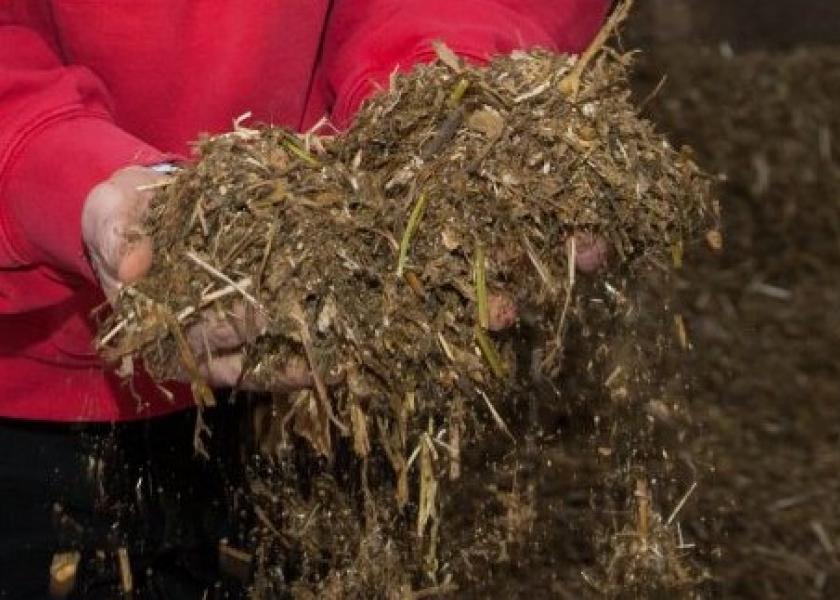How to Make Fiber More Digestible

When a cow is grazing, she will naturally choose the shortest forage possible because it likely has the least lignin, gives her the most energy and is the easiest to chew. The problem cows run into is the initial particle length of forage in their diet. Hay being fed in the winter could have a length of 1.5 feet or even up to 3 feet if it's first cutting hay.
How Forage is Digested
Forage is broken down in the rumen by first chewing or mastication; then the cow swallows the bolus of feed, and it enters the rumen. With bacteria, the enzymes responsible for breaking down the forage particles - cellulose and hemicellulose – need to attach to the forage particle.
“The forage has to be moistened which creates oxygen bubbles, but oxygen is toxic to bacteria,” said Dr. Francis Fluharty, Animal and Dairy Science Department head at the University of Georgia. “The rumen eliminates the oxygen by contracting about twice a minute which causes cattle to eructate gas. They're eliminating the oxygen and carbon dioxide. As that process occurs, the forage particle is being mixed and moistened, so the bacteria can attach. This is the lag phase of digestion.”
Forages are digested from the inside to the outside. Grasses have a waxy cuticle layer on the outside of the grass that can’t be penetrated by bacteria. To increase forage digestibility, you must break apart the cuticle layer. This occurs by the animal chewing its cud, whereby the animal brings back up a bolus of forage, chews it more to further break it apart, then re-swallows it, so the bacteria can attach. From the rumen, it moves down the digestive tract to the reticulum, where the big forage particles pass back and forth. Once out of the reticulum, the forage goes to the omasum, and forage particles leave the rumen at about 1/25th of an inch in length.
“How much energy does it take the cow to break the forage particle down from 3 feet to 1/25th of an inch?” Fluharty said. “The most important thing a producer can do to help fiber digestibility is to chop the hay prior to the animal eating it. It’s also important to time harvest prior to lignin building up.”
A group of microorganisms called the rumen fungi can break the bond between the lignin and the hemicellulose in forage. Rumen fungi are several times larger than bacteria, and they grow rapidly in the rumen through the forage particles and can carry the bacteria with them.
“Another step a producer can take is to a feed supplement that has shown to increase the rate of fiber digestion,” he explained. “Levucell SC is a yeast product by Lallemand, and Amaferm by Biozyme Incorporated is a prebiotic – they have both shown to increase the growth rate of rumen fungi.”
Since the goal is to start with as small a particle size as possible, using a mower conditioner with rollers when making hay can help break down that outer cuticle layer and crush forage, so there are more cracks in the forage during drying. The second option is to use a chop cut round baler that will break particles down to 6 or 8 inches.
Haylage
“If I had to choose between feeding dry hay or haylage, I would choose haylage because it’s already wetted, and you can still use a chop cut baler when you're making haylage. If you're ensiling in a bunker or a bag, it's already being chopped down hopefully to no more than 2 to 3 inches in length with 2 inches being optimal. Plus, producers have a much better chance of keeping cows in good condition through the winter with the haylage bale because the rate of digestion is going to be faster.”
Corn Silage
As with haylage, corn silage is also already wet when it goes into the rumen, so the lag time for digestion is much less than for a dry forage. The other benefit of corn silage is that it's been chopped to a particle length of about 1/2 inch to ¾ inch long. Corn silage is an exceptional feed from a forage digestibility standpoint, according to Fluharty. However, it can cause other concerns for beef cows.
“If I'm feeding pregnant cows through the winter on corn silage, on a dry matter basis, corn silage is approximately 50% corn. When digested, it increases the glucose produced in the liver which results in more propionate in the rumen that’s converted to glucose which is absorbed by the fetus and can ultimately increase calf birth weight,” he noted. “Another downside is that when you give more energy through corn, milk production is increased. If the calf cannot consume all the milk, the cow could become mastitic. It’s a good feed but only about 25% to 30% of dry matter intake should come from corn silage.”

Headline photo courtesy of Troy Walz and University of Nebraska
To read more articles like this one:
Optimize Corn Silage Harvest to Maximize Your Ration
Corn Silage Harvest: Want More Money in the Bunker?
Five Key Priorities for Making Quality Silage
Drovers
Four Strategies to Plan you Silage Season
Crop Selection Planning for the Next Silage Season
Crop Nutrient Needs for Alfalfa and Corn Silage







